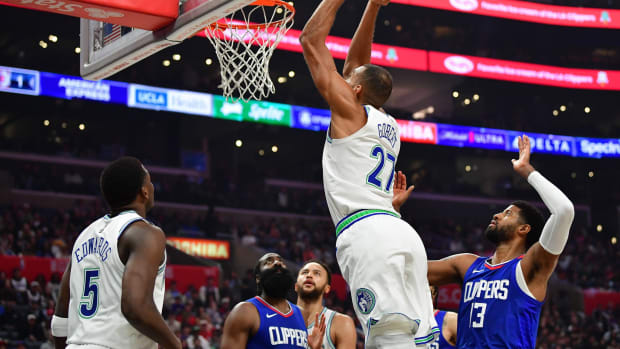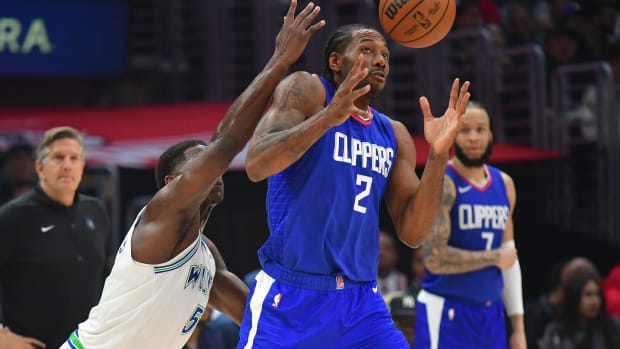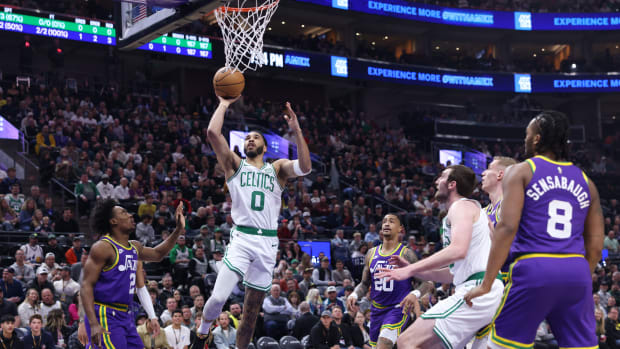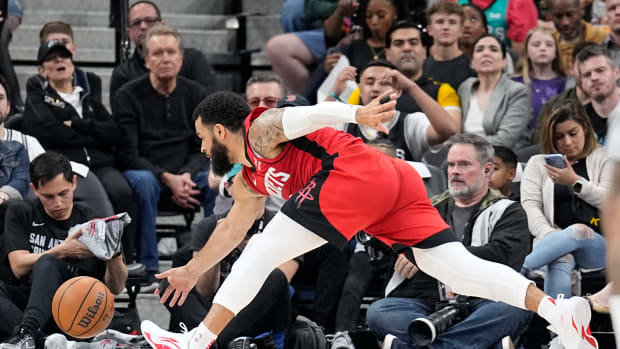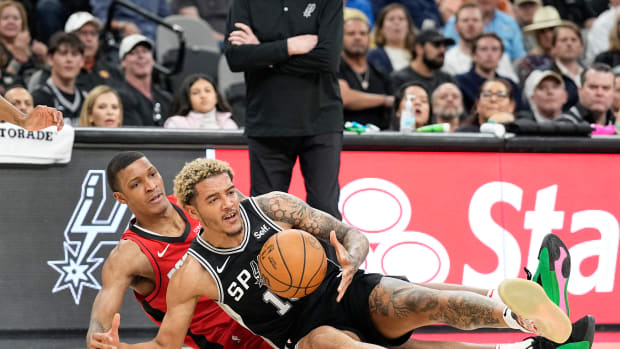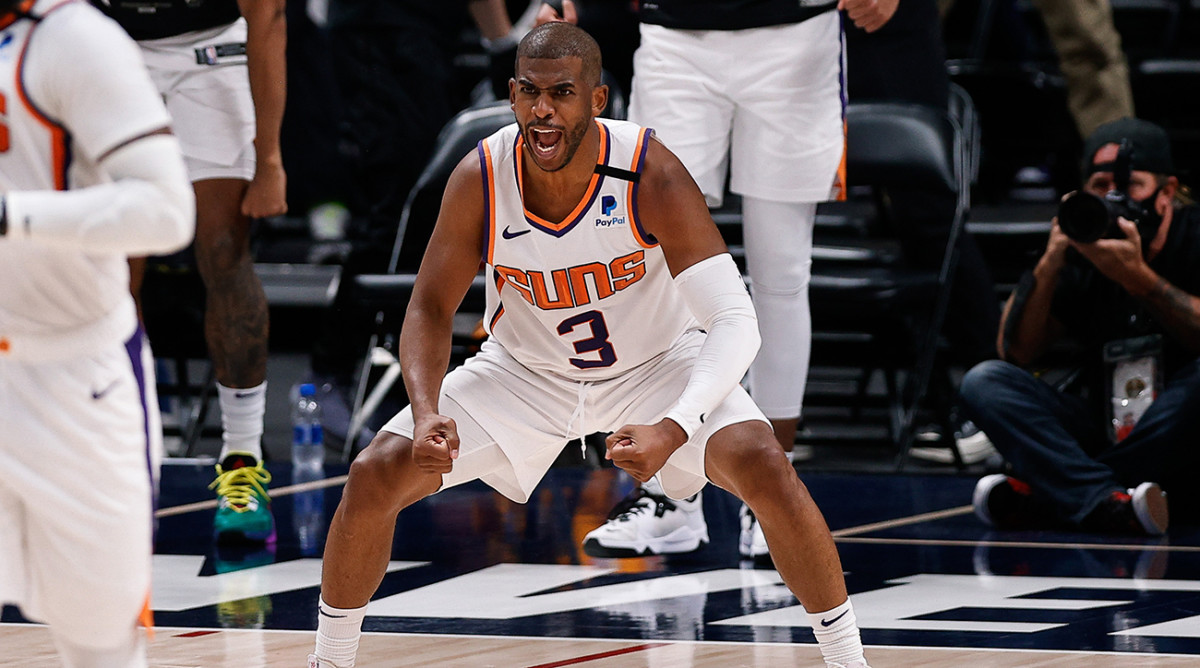
NBA Point Guard Musical Chairs
As free agency kicks off later today, the formidable list of starting-caliber point guards who are available to sign or trade for may reshape the 2021–22 season’s title race. At the same time, given the position’s increasingly ambivalent role in a game that’s less interested in structure than it is sheer velocity, these transactions may ultimately fizzle before having the type of impact common sense expects them to.
It’s possible we see every relevant point guard stay put, but—especially after Russell Westbrook was traded to the Lakers—a game of musical chairs is just as likely, given the number of teams that need/want someone to shepherd their offense.
A peek at some specifics: Despite being way past the wrong side of 30, Chris Paul, Kyle Lowry and Mike Conley are all still able to make a very good team great. Dennis Schröder, Reggie Jackson and Spencer Dinwiddie will also be around, while Derrick Rose, Devonte’ Graham and Patty Mills may also be in demand as beneficial floor generals off the bench.
Kemba Walker is gettable (now even more than before the Thunder drafted Josh Giddey and Tre Mann) for any front office that’s comfortable paying the $73.6 million he’s guaranteed over the next two seasons, and Ricky Rubio was just dealt to a Cavaliers team that already has Collin Sexton and Darius Garland.
Ben Simmons and Lonzo Ball (a restricted free agent) aren’t ball-dominant playmakers in the traditional or modern sense, but can be pushed into this conversation if you shove hard enough. And, finally, hovering above everybody else is Damian Lillard, a marvel whose exit from the Trail Blazers would be an NBA earthquake if it ever actually happens.
Balancing out the marketplace are teams that should enter this offseason looking to sign/trade for/retain at least one of the point guards mentioned above: the Knicks, Heat, Mavericks, Raptors, Sixers, Suns, Jazz, Pelicans, Wizards, Clippers, Celtics and Bulls. That’s over a third of the league.
Not all of these organizations have the same means or appetite to acquire a pricey point guard, but all should show interest. Only a few will land their first choice, obviously, forcing others to pivot down the line and generating a fascinating plot mover, weeks after a classic Finals was fought by two teams that only got that far after upgrading their own starting point guard with a trade during last year’s offseason.
From that sense, where Lowry, Paul, Conley and a few others actually land really matters! Simultaneously, at a time when positions have already become an abstract concept, what does a point guard even mean anymore? Are they worth a hefty investment?
It's more than fair to assert that the value of a typical point guard has diminished in a league that fetishizes big wings who can dribble, shoot, rumble to the rim in transition, make every pick-and-roll read there is, and create something out of nothing when a possession has seemingly reached a dead end. Luka Dončić, James Harden, LeBron James, Paul George, Kawhi Leonard, Kevin Durant, Jimmy Butler, Jayson Tatum and Khris Middleton, to name a few, are the centerpieces who really matter.
And then there are bigs, like Nikola Jokić, Draymond Green, Domantas Sabonis, Zion Williamson, Giannis Antetokounmpo, Julius Randle and Bam Adebayo, who’ve flipped time-honored positional designations on their head. It’s role reversal. They handle the ball with ease (though sometimes not as much care) and set up smaller teammates instead of it being the other way around. These big men are also able to fake dribble handoffs, and grab and go after a defensive rebound—effectively cutting out the middleman by shortcutting outlet passes to the point guard.
In the same way the game’s need for skill at all five positions has placed some centers on the endangered species list, it’s also affected the position that used to be more synonymous with play creation than any other. Aside from a few exceptional examples (Steph Curry, Lillard, Trae Young) the duty that relatively bite-sized ballhandlers are asked to fill has shrunk. The expansion of positionless basketball, crossed with an increasing need to have enough size for capable 1–4 or 1–5 switching, has made the point guard less vital in increasingly randomized offenses that are less reliant on synchronized half-court execution.
In five years, point guards will likely function with even less importance and monetary value than they do today, where slight table-setters are far more serviceable off the bench—if at all in the playoffs, when they turn into a liability—even if they can shoot. But right now there are still a few who organize, soothe and strike with a contagious poise that’s worth every penny. Give them a high ball screen and they’ll dice up the defense, with priceless leadership qualities that are impossible to quantify beyond “wins” and “losses.” There’s a good chance nobody is better tapped into their team’s on and off-court disposition, either. These point guards set the tone, reorient priorities on a possession-to-possession basis and share knowledge with teammates who need it.
The very best (a few of which may technically come available this week) can provide intention and purpose. They sift through chaos and understand pacing. When the time is right to break off a set, they do. When the moment calls for a strict line read, they give one.
The three playoff teams with cap space that are most in need of someone exactly like this are the Heat, Mavericks and Knicks. The first two have to make some difficult internal decisions in order to clear enough room, but they can if they have the stomach to do so. And then there are the Pelicans, who didn’t make the playoffs but could go a similar route in aspiring to be like last year’s Suns.
There are also teams that don’t have space—the Sixers, Celtics, Bulls and Clippers—and will try to execute a trade in some shape or form to acquire who they want. Unfortunately for them, before the proceedings even begin, some of the more attractive options may already be off the table or beyond their means. NBA teams are creative, though, and breaking down every possible outcome is pretty much impossible at this point, given the number of buyers and sellers. Here’s a closer look at the major players.
According to Marc Stein, the Jazz are preparing to offer Conley a three-year, $75 million contract, an offer that was telegraphed by the team’s decision to shed Derrick Favors’s salary last week. Without any mechanism to replace Conley’s production, losing him isn’t really an option for Utah, though it’s still possible other suitors may emerge to drive up his price.
There are 61 players who pulled up for at least 100 threes last season. Conley was the most accurate, canning 41.5% of his 205 tries. There’s a chance this number can’t be sustained in another environment without a devoted, hard-diving pick-and-roll partner like Rudy Gobert, against defenses that aren’t forced to put their top on-ball instigator on someone like Donovan Mitchell, Bojan Bogdanović or Jordan Clarkson. Regardless, that type of shooting forces contending teams to pay attention; when it comes attached to a steady presence who doesn’t require his own number to be called and can also hit a floater with either hand, said teams lean forward in their seats and do more than merely daydream about how Conley would look wearing their jersey.
The Heat could’ve almost matched the Jazz’s reported bid by renouncing all their free agents (and pulling the qualifying offers for Kendrick Nunn and Duncan Robinson), then declining team options for Goran Dragić and Andre Iguodala, but instead they picked up Dragić’s option in an attempt to include him in a potential sign-and-trade for Lowry, who reportedly wants $90 million over three years.
Lowry is very good and it’s nice that he wants that much money. But he also turns 36 in March, and only 17 players logged more minutes over the past five seasons. That dollar amount also curbs the number of teams that can realistically acquire him without sacrificing much of their own talent. (Welcome to New York, Kyle!) We’ll see whether he’s forced/willing to drop that asking price and slide into the cap space Dallas (the Mavericks would need to renounce Tim Hardaway Jr.) or New Orleans have.
All those destinations are alluring for Lowry. In New Orleans he’d provide instant respectability to a franchise that has not been able to get out of its own way. The Pelicans can renounce their free agents (including Ball) and outright pay Lowry the rate he wants. (A quick aside: Paul isn’t receiving too much space in this column because it’s so hard to picture him leaving Phoenix, but it would be interesting for him to consider a move back to New Orleans, where his career could come full circle under new Pelicans head coach Willie Green—who just coached Paul in Phoenix and was his teammate for three seasons with the Pelicans and Clippers—beside young talents like Brandon Ingram and Zion.)
In Dallas, Lowry could be the difference-maker in a way Paul just was for the Suns, raising the team’s ceiling and floor as an ideal complement for Luka and Kristaps Porziņģis. Those Mavs would be a definite contender. The Knicks almost landed Lowry several years ago and can outbid every other buyer if money is more of a deciding factor than winning. But whether another stab at the title matters, Lowry can also complete the NBA’s grittiest Big Three beside Butler and Adebayo. That trio would also fit seamlessly.
Miami’s decision to pick up Dragić’s option is good news (for the time being, i.e. he may get re-routed to Dallas and to fill their void) for several other free agents, including Dinwiddie, a notable alternative for any team that still has its sights on Paul, Lowry or Conley. His size and ability to draw fouls help make up for a questionable three-point shot, though that particular shortcoming makes him less desirable for teams that don’t need him to have the ball in his hands on every play.
Coming back from an ACL injury, there’s a chance he enters All-Star conversations at some point on this next deal. Sign-and-trades are tricky to pull off and there aren’t too many feasible options here, but the Nets would be wise to explore every possibility as an extremely expensive team with few tools to improve.
Bleacher Report’s Jake Fischer reported over the weekend that Dinwiddie could head to Washington for either Kyle Kuzma or Montrezl Harrell. What about to Chicago for Tomáš Satoranský or Thaddeus Young? The Clippers would be a nice destination but can’t take him in that type of deal without hard-capping themselves. And that lacking outside shot makes Dinwiddie less logical for the Heat, where a three-point marksman (like Lowry or Conley) fits better beside their two franchise pillars.
In theory, Jackson would be a decent placeholder in South Beach, assuming a role that allows him to focus on making every shot he takes—which is essentially what just happened in the playoffs. And if the Clippers can’t re-sign Jackson, they have a few young players who Sam Presti might be happy to take off their hands for Walker (though Kawhi’s ACL injury plus the helpful salary that would need to be in the deal—Marcus Morris, Pat Beverley, Luke Kennard, etc.—make any transaction unlikely). If the Knicks lose out on Lowry, Conley and Paul, then say thanks but no thanks to Schröder; Walker would be a decent Plan B assuming Oklahoma City doesn’t ask for the moon. (There are, of course, several intriguing non-point-guards— Robinson, DeMar DeRozan, etc.—who New York may favor instead.)
If the Bulls can’t land Ball and find themselves in a desperate situation, they could also find themselves sniffing around for Walker, who could be acquired for Thaddeus Young and Satoransky, two helpful vets the Thunder can potentially flip for picks during the season. Consider that scenario less probable than simply using their midlevel on Rose or even trying to pry Graham from the Hornets.
On a short-term pact that allows him to build his value back up, Schröder also isn’t a terrible consolation prize. He’d be embraced by any team that needs a north-south beeline who can pretty much get to his right hand whenever he wants. But anyone who signs Schröder must weigh his limitations against the role he believes he’s able to fill. (Schröder has not made more than 30% of his pull-up threes in any season since 2015.) Off the ball he isn’t terrible, but finding the right balance isn’t possible in every situation.
Schröder had effectively simple pick-and-roll chemistry with Montrezl Harrell, Anthony Davis and Andre Drummond last year, and when you watch some of L.A.’s muddiest possessions, it’s easy to picture him taking advantage of lineups that can accentuate his speed as opposed to curtailing it. Schröder is only 27 and would be devastating in space. Would he accept the midlevel from a team like the Clippers, Bulls or Sixers? What about signing for a bit more money in Toronto, if it loses Lowry for nothing?
In a similar camp sits Rose, who quietly finished third for Sixth Man of the Year last season and still feels, at 32 years old, on the cusp of winning it. Chicago or New Orleans would, in all likelihood, prefer the former MVP’s decision-making (and price tag) if pressed to choose between him and Schröder, even if it’s only a one or two-year agreement.
Every possible permutation here is enough to make your head throb. They also create an interesting dialogue about the position’s worth and how point guards have seen their general role ebb in recent years. At the same time, until the league is truly flush with larger wings and big men who carry the sensibilities any good point guard must have—who see the court, read opponents and place themselves one step ahead of a help rotation—point guards will be sought after as the composed release valves they’re still asked to be; not having a vibrant, dynamic or rock-solid option to feed themselves and elevate their teammates (instead of it being the other way around) can create adverse consequences, even as defense, rebounding and physicality are sacrificed.
Whether they stay or go, Paul, Lowry, Conley and (maybe) a couple of others all hold the immediate fortunes of several teams in the palm of their hand. The position’s more traditional characters are having a meaningful moment, even if it’s fleeting, in a league that is steadily evolving to wipe them out entirely.
More NBA Coverage:
• NBA Free Agency Mailbag
• NBA Free Agency Preview
• 2021 NBA Free Agency: Ranking the Top 50 Players
• Which Team Should Trade for Damian Lillard?






























